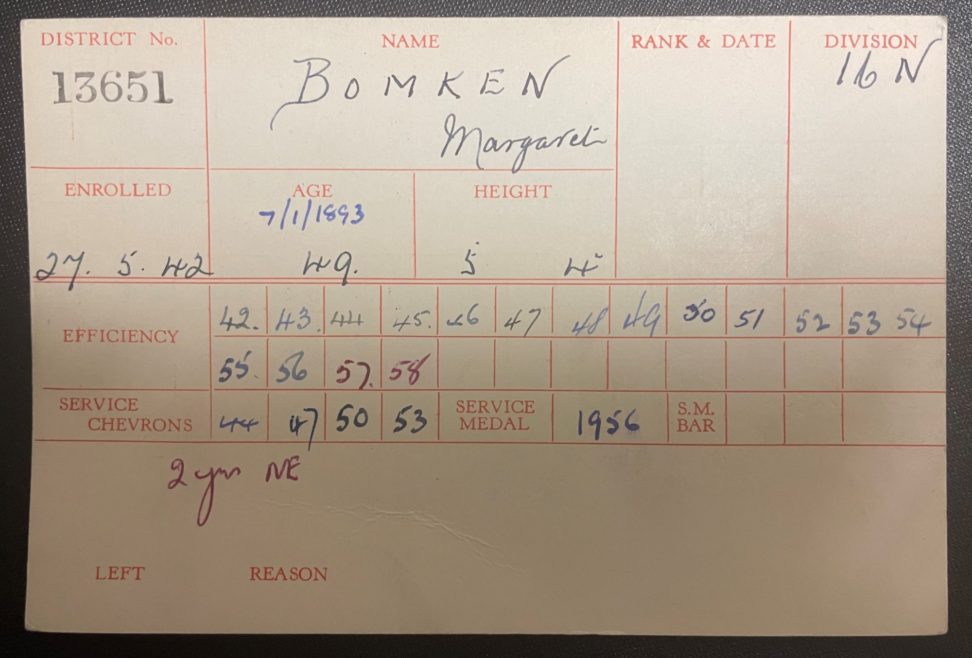This week is Explore Your Archive week, an annual celebration of all things archive-y, organised by the Archives & Records Association (UK & Ireland) to encourage everyone to visit, use, celebrate, and be inspired by archives across the UK & Ireland. On today’s theme of #EYASmall, let’s explore this record card from the Archive collection for one of the many female members of the St John Ambulance Brigade: Margaret Bomken.

The biographical information tells us about a woman called Margaret Bomken who was born on 7th January 1893. She was 49 years old when she joined the St John Ambulance Brigade on 27th May 1942 (a Wednesday), at the age of 49, and she is recorded as being 5 foot and 4 inches tall. Margaret joined a Division of the Brigade (a local group) coded as ‘16N’, otherwise known as the New Cross Nursing Division, in southeast London. At the time, Divisions separated men into Ambulance Divisions, and women into Nursing Divisions, where their first aid syllabus had a stronger focus on the nurturing and nursing side of first aid (including bedmaking!)
The section titled ‘efficiency’ identifies the years in which Margaret was an efficient member. Efficiency (a rather an outdated term now) was granted on a yearly basis, and to be an efficient member, volunteers with the St John Ambulance Brigade must have passed their First Aid Re-examination, uniform inspection, and undertaken duty hours. We can see from Margaret’s card that she was an efficient member for 17 years, from 1942 until 1958.
The section titled ‘service chevrons’ identifies the years in which Margaret became entitled to wear service chevrons on her uniform. This entitlement was granted to members who served for three consecutive years with the Brigade, and Margaret’s service chevrons were awarded in 1944, 1947, 1950, and 1953.
The section titled ‘Service Medal’ identifies the year in which Margaret was awarded her Service Medal. Service medals were granted to members of the Brigade who had (at the time) been efficient for 15 consecutive years, and Margaret was awarded her Service Medal in 1956. The section titled ‘SM Bar’ identifies how many Bars were awarded to Margaret. ‘Bars’ were awarded to recipients of the Service Medal who achieved 5 further years of continuous efficient service. They are small, slim, and silver, and are attached to the ribbon of the Service Medal. If you would like to know more about Service Medals and Bars, check out this blog post.
Margaret’s leaving date was not filled in on her card, so we don’t know exactly when she left, although we can assume that she left in 1958 after achieving efficiency, or in 1959, as that date is not recorded in her efficiency.
Margaret joined the St John Ambulance Brigade in the middle of the Second World War, and St John was incredibly busy with a whole range of war work. If you would like to know more about St John during this time, why not check out this blog post.
From one physically small record, we can unearth quite a bit of information, and gain some insight into Margaret’s time with the St John Ambulance Brigade. This record is indeed small, but also mighty.



